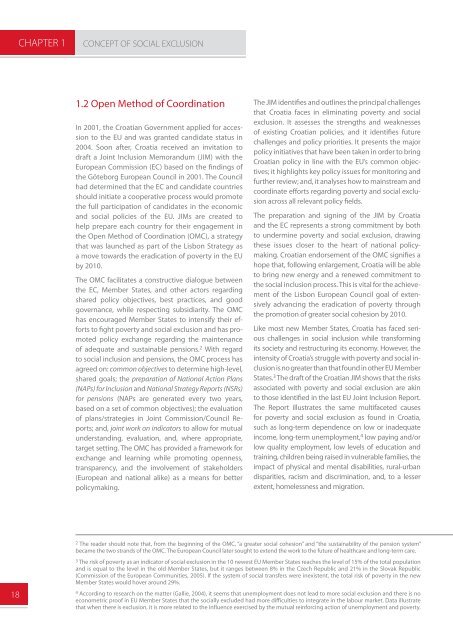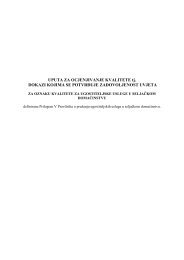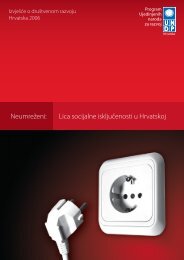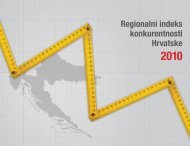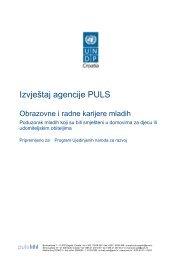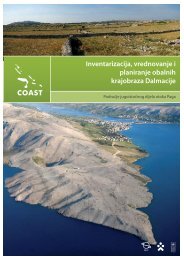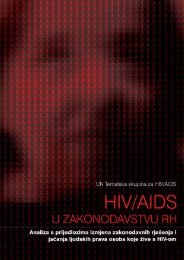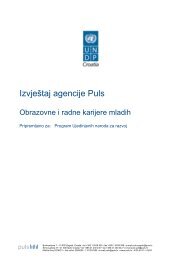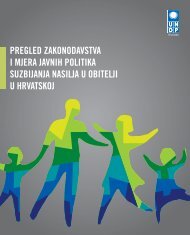WEB engleska verzija end.indd - UNDP Croatia
WEB engleska verzija end.indd - UNDP Croatia
WEB engleska verzija end.indd - UNDP Croatia
- No tags were found...
You also want an ePaper? Increase the reach of your titles
YUMPU automatically turns print PDFs into web optimized ePapers that Google loves.
CHAPTER 1CONCEPT OF SOCIAL EXCLUSION1.2 Open Method of CoordinationIn 2001, the <strong>Croatia</strong>n Government applied for accessionto the EU and was granted candidate status in2004. Soon after, <strong>Croatia</strong> received an invitation todraft a Joint Inclusion Memorandum (JIM) with theEuropean Commission (EC) based on the findings ofthe Göteborg European Council in 2001. The Councilhad determined that the EC and candidate countriesshould initiate a cooperative process would promotethe full participation of candidates in the economicand social policies of the EU. JIMs are created tohelp prepare each country for their engagement inthe Open Method of Coordination (OMC), a strategythat was launched as part of the Lisbon Strategy asa move towards the eradication of poverty in the EUby 2010.The OMC facilitates a constructive dialogue betweenthe EC, Member States, and other actors regardingshared policy objectives, best practices, and goodgovernance, while respecting subsidiarity. The OMChas encouraged Member States to intensify their effortsto fight poverty and social exclusion and has promotedpolicy exchange regarding the maintenanceof adequate and sustainable pensions. 2 With regardto social inclusion and pensions, the OMC process hasagreed on: common objectives to determine high-level,shared goals; the preparation of National Action Plans(NAPs) for Inclusion and National Strategy Reports (NSRs)for pensions (NAPs are generated every two years,based on a set of common objectives); the evaluationof plans/strategies in Joint Commission/Council Reports;and, joint work on indicators to allow for mutualunderstanding, evaluation, and, where appropriate,target setting. The OMC has provided a framework forexchange and learning while promoting openness,transparency, and the involvement of stakeholders(European and national alike) as a means for betterpolicymaking.The JIM identifies and outlines the principal challengesthat <strong>Croatia</strong> faces in eliminating poverty and socialexclusion. It assesses the strengths and weaknessesof existing <strong>Croatia</strong>n policies, and it identifies futurechallenges and policy priorities. It presents the majorpolicy initiatives that have been taken in order to bring<strong>Croatia</strong>n policy in line with the EU’s common objectives;it highlights key policy issues for monitoring andfurther review; and, it analyses how to mainstream andcoordinate efforts regarding poverty and social exclusionacross all relevant policy fields.The preparation and signing of the JIM by <strong>Croatia</strong>and the EC represents a strong commitment by bothto undermine poverty and social exclusion, drawingthese issues closer to the heart of national policymaking.<strong>Croatia</strong>n <strong>end</strong>orsement of the OMC signifies ahope that, following enlargement, <strong>Croatia</strong> will be ableto bring new energy and a renewed commitment tothe social inclusion process. This is vital for the achievementof the Lisbon European Council goal of extensivelyadvancing the eradication of poverty throughthe promotion of greater social cohesion by 2010.Like most new Member States, <strong>Croatia</strong> has faced seriouschallenges in social inclusion while transformingits society and restructuring its economy. However, theintensity of <strong>Croatia</strong>’s struggle with poverty and social inclusionis no greater than that found in other EU MemberStates. 3 The draft of the <strong>Croatia</strong>n JIM shows that the risksassociated with poverty and social exclusion are akinto those identified in the last EU Joint Inclusion Report.The Report illustrates the same multifaceted causesfor poverty and social exclusion as found in <strong>Croatia</strong>,such as long-term dep<strong>end</strong>ence on low or inadequateincome, long-term unemployment, 4 low paying and/orlow quality employment, low levels of education andtraining, children being raised in vulnerable families, theimpact of physical and mental disabilities, rural-urbandisparities, racism and discrimination, and, to a lesserextent, homelessness and migration.182 The reader should note that, from the beginning of the OMC, “a greater social cohesion” and “the sustainability of the pension system”became the two strands of the OMC. The European Council later sought to ext<strong>end</strong> the work to the future of healthcare and long-term care.3 The risk of poverty as an indicator of social exclusion in the 10 newest EU Member States reaches the level of 15% of the total populationand is equal to the level in the old Member States, but it ranges between 8% in the Czech Republic and 21% in the Slovak Republic(Commission of the European Communities, 2005). If the system of social transfers were inexistent, the total risk of poverty in the newMember States would hover around 29%.4 According to research on the matter (Gallie, 2004), it seems that unemployment does not lead to more social exclusion and there is noeconometric proof in EU Member States that the socially excluded had more difficulties to integrate in the labour market. Data illustratethat when there is exclusion, it is more related to the influence exercised by the mutual reinforcing action of unemployment and poverty.


